No edit summary Tag: Visual edit |
mNo edit summary Tag: Visual edit |
||
| (30 intermediate revisions by 4 users not shown) | |||
| Line 1: | Line 1: | ||
| − | [[File:40050.png|thumb|100x100px|left|The OmnIcon of The Realm of Man]] |
+ | [[File:40050.png|thumb|100x100px|left|The OmnIcon of The Realm of Man]] |
| + | [[File:People Cave Painting.jpg|thumb|323x323px|Guests explore one of the Realm's painted caves, circa 1979]] |
||
| + | '''The Realm of Man''' was designed to evoke the primordial state of prehistoric humankind. |
||
| + | |||
| + | Set in a series of mammoth-bone tents, caves, tundras, forests and savannas, it transported guests millions of years into the past, where they relived the evolutionary history of the human species. |
||
==History== |
==History== |
||
| − | When OmniPark opened in March 1977, this Realm was originally called The Realm of Mind, and was focused on the human brain — specifically, on human consciousness. |
+ | When OmniPark opened in March 1977, this Realm was originally called [[The Realm of Mind]], and was focused on the human brain — specifically, on human consciousness. |
| − | Its original attraction was a ride called "[[The Mystery of Consciousness]]," which simulated the evolution of human consciousness from a first-person perspective, |
+ | Its original attraction was a ride called "[[The Mystery of Consciousness]]," which simulated the evolution of human consciousness from a first-person perspective. Narrated by a shamanic woman called the [[Chemist]], this attraction culminated in a colorful simulation of an [https://www.wikiwand.com/en/Lysergic_acid_diethylamide LSD] trip. Documentation of this attraction (and of the Realm as it originally looked) survives only in the form of storyboards and photos published in the 1978 souvenir book "[[A Journey Through OmniPark]]." |
| − | Facing intense criticism from parents for apparent endorsement of drug use — an accusation bolstered by the fact that members of the hippie community (including |
+ | Facing intense criticism from parents for apparent endorsement of drug use — an accusation bolstered by the fact that members of the hippie community (including [https://www.wikiwand.com/en/Ken_Kesey Ken Kesey] and [https://www.wikiwand.com/en/Timothy_Leary Timothy Leary] '''<sup>[[https://en.wikipedia.org/wiki/Wikipedia:Citation_needed citation needed]]</sup>''') frequently made "pilgrimages" to the park specifically to experience this Realm and its attraction while under the influence of psychedelic drugs — OmniPark demolished the attraction at the end of the tourist season in October 1979. |
The entire Realm was closed until May 1981, when its Grand Reopening introduced its new branding as The Realm of Man, featuring "The Story of Man" as its main attraction. |
The entire Realm was closed until May 1981, when its Grand Reopening introduced its new branding as The Realm of Man, featuring "The Story of Man" as its main attraction. |
||
== Realm Layout and Design == |
== Realm Layout and Design == |
||
| + | The Realm's entrance took the shape of a giant arch of mammoth tusks. Passing through this entryway, guests emerged into the '''Great Tent''': an enormous vaulted house constructed of bones, pelts and furs. At the center of the tent, a hole let in sunlight. Stone weapons and furs were scattered all around. |
||
| − | While most of the Realm's environment was patterned on the tundras and pine forests of the last Ice Age, certain areas evoked even older human habitats, such as the savannas of Africa. |
||
| + | |||
| + | [[File:Realm_of_Man_-_Great_Tent.jpg|thumb|The Great Tent|269x269px]]The Great Tent's west-facing opening led to the [[Feasting Cave]] -- one of OmniPark's most unique dining experiences. Under a cave ceiling painted with scenes of the hunt, guests could dine on pit-roasted deer, boar, and other wild-caught meat. |
||
| + | |||
| + | '''''<nowiki>{{</nowiki>The following paragraph contains one or more statements whose factual nature is in dispute. [https://omnipark.fandom.com/wiki/Disputes_on_the_OmniPark_Wiki Read more about disputes on the OmniPark Wiki].<nowiki>}}</nowiki>''''' |
||
| + | |||
| + | From 1981 to 1983, park ambassadors clad in furs and animal-bone jewelry would butcher captive gazelles, oryx, deer, rabbits and other animals ''live'' in front of guests, using actual flint tools'''<sup>[[https://en.wikipedia.org/wiki/Wikipedia:Citation_needed citation needed]]</sup>'''. OmniPark discontinued this practice in response to public outcry over animal cruelty '''<sup>[[https://en.wikipedia.org/wiki/Wikipedia:Citation_needed citation needed]]</sup>'''. |
||
| + | |||
| + | The Great Tent's east-facing opening led to the Amphitheater -- an open-air performance space where guests could watch a performance that recreated stone-age music. |
||
| + | [[File:Heilung - LIFA - Krigsgaldr LIVE|thumb|330x330px]] |
||
== Attraction: The Story of Man == |
== Attraction: The Story of Man == |
||
This attraction invited guests to travel back to the dawn of human evolution. |
This attraction invited guests to travel back to the dawn of human evolution. |
||
| + | |||
| + | As they passed through the queuing area, guests would be treated to murals depicting early hominid habitats such as African savannas and jungles, painted caves, European meadows, pine forests, and the Ice Age tundra. The ride’s boarding area was designed to resemble the painted caves of [https://www.ancient.eu/Lascaux_Cave/ Lascaux] and [https://www.ancient.eu/Chauvet_Cave/ Chauvet]. There, guests boarded four-seater ride vehicles that appeared to be lashed together from mammoth bone and leather. |
||
| + | |||
| + | These vehicles entered a pitch dark room, where animated images of early hominid ancestor species were projected across the domed ceiling and walls. In the opening narration, guests met the '''[[Anthropologist]]''' (voiced by New York-trained theater actor [[Roger Forrester]], who provided numerous voiceovers throughout OmniPark). |
||
| + | |||
| + | The Anthropologist declared that the only way to understand mankind was to go “back to the very beginning.” Reassuring guests that he had used the [[The Inventor|Inventor]]'s [[Time Tunneler]] technology many times, and had always returned healthy and intact, the Anthropologist opened a spacetime tunnel to “the savanna of Kenya, circa four million years ago.” |
||
| + | [[File:Australopithecus and cat.jpg|thumb|320x320px|A group of animatronic ''Australopithecus'' protect their kill]] |
||
| + | On this dry grassland, guests saw a troop (or possibly several different troops) of ''[https://www.wikiwand.com/en/Australopithecus# Australopithecus]'' foraging for roots and nuts, fighting off hyenas and big cats, and chasing away a troop of “less evolved” apes by hooting and throwing rocks. |
||
| + | |||
| + | In a nighttime scene, riders saw the troop huddled together against the cold, in a circle they’d cleared within the tall grass. “They are cold,” the Anthropologist explained, “because they know fire only as an enemy — not yet as a friend.” He went on to explain that, because they have not evolved language, “Each of them is alone in his own mind.” |
||
| + | |||
| + | Passing through another dark chamber, riders emerged in “[https://www.britannica.com/place/Olduvai-Gorge Tanzania’s Olduvai Gorge], two million years later.” There, they witnessed a band of animatronic ''[https://www.wikiwand.com/en/Homo_habilis Homo habilis]'' stalking a herd of zebras, coordinating their attack with a system of chirps and whistles. “By imitating the songs of birds,” the Anthropologist explained, “they have begun to invent something new: language.” (This was one prevailing theory in the late 1970s.) |
||
| + | [[File:Homo habilis fire.jpg|left|thumb|228x228px|Animatronic ''Homo habilis'' and their fire]] |
||
| + | Riders watched as the ''Homo habilis'' cornered and butchered a young zebra - then roasted its flesh over a wildfire burning in the grass. “They have not yet tamed fire,” the Anthropologist explained as guests observed the feast, “but at last, they have befriended it.” |
||
| + | |||
| + | “But something is wrong!” the Anthropologist suddenly exclaimed. “The hunters have become the hunted!” A series of guttural cries alerted the ''Homo habilis'' troop to the presence of a pack of carnivorous hominids nearby. |
||
| + | The ride vehicles followed the fleeing ''Homo habilis'' into a nearby cave, which was pitch dark. The Anthropologist cautioned guests to remain absolutely still and silent, “For we are hunted by ''Pithecanthropus erectus''” [the scientific name for ''Homo erectus'' prior to the 1990s]. |
||
| + | |||
| + | In one of OmniPark’s most memorable scenes, riders were surprised by puffs of animal-scented air as the troop of “''[https://www.wikiwand.com/en/Java_Man Pithecanthropus erectus]''” sniffed them in the pitch darkness of the cave. Robotic “hands” emerged from the ride vehicles, giving the sensation that the hunters were pawing and pinching riders’ flesh. At last, a series of high-pitched screams gave evidence that the hunters had killed some of the younger ''Homo habilis'', and were beginning to eat them. |
||
| + | |||
| + | The ride vehicles lurched forward out of the cave, emerging in “[https://www.wikiwand.com/en/Great_Rift_Valley,_Ethiopia Ethiopia’s Great Rift Valley], just over a million years later.” Here, riders got their first view of “anatomically modern ''Homo sapiens'',” who resembled South Africa’s [https://www.wikiwand.com/en/San_people San people]. These hunters used spears and bows to take down a wild ox with great expertise - still using similar bird-like calls to coordinate their tactics. |
||
| + | [[File:Homo sapiens hunters.jpg|thumb|295x295px|Animatronic ''Homo sapiens'' coordinate their hunt]] |
||
| + | Later, in a rock shelter, riders watched as the animatronic humans used tools to turn the ox’s flesh into leather for clothing, its bones into knives, and its organs into bags and bowstrings. A shaman chanted while the tribe’s women painted scenes of the hunt on the rock shelter’s wall. |
||
| + | |||
| + | The ride vehicles then passed into a chamber where an animated map depicted humankind’s migration across the earth - from eastern Africa across Europe and Asia, throughout the Pacific, and finally into North and South America. |
||
| + | |||
| + | “But we ''Homo sapiens'' were not alone in this wide world,” the Anthropologist explained, as the ride vehicles emerged onto an Ice Age tundra, “less than a hundred thousand years ago.” There, a tribe of humans - now clad in sewn clothing of fur and hide - battled a clan of [https://www.livescience.com/28036-neanderthals-facts-about-our-extinct-human-relatives.html Neanderthals], who fought with stone-tipped spears. |
||
| + | [[File:Neanderthal-burial-ritual.jpg|left|thumb|302x302px|1975 concept art for the Neanderthal funeral scene]] |
||
| + | The ''Homo sapiens'' killed most of the Neanderthals - yet strangely, the riders were taken not to the humans’ victory celebration, but to the [https://www.nationalgeographic.com/news/2013/12/131216-la-chapelle-neanderthal-burials-graves/ Neanderthals’ funeral]. Older Neanderthals wept, while younger ones placed garlands of flowers in the graves, and an ancient shaman chanted to a giant cave bear skull. |
||
| + | |||
| + | (In the ride’s original 1981 design, this scene also included a captive human woman being sexually assaulted by two Neanderthals - but this tableau was removed in 1983 following guest complaints '''<sup>[[https://en.wikipedia.org/wiki/Wikipedia:Citation_needed citation needed]]</sup>'''.) |
||
| + | |||
| + | “Fierce and hardy though they were,” the Anthropologist explained, “the Neanderthals were defeated in the end.” The ride vehicles emerged into a mammoth-bone village, where men and women sewed complex garments, constructed bows and arrows, and carved and painted art - all while speaking to one another in the most complex language yet heard. |
||
| + | |||
| + | The vehicles then entered a vast chamber, filled with animated depictions of all the hominid species encountered throughout the ride. “The story of man is not simply the story of ''Homo sapiens'',” the Anthropologist explained. “It is the story of all of us.” |
||
Latest revision as of 17:18, 16 July 2020

The OmnIcon of The Realm of Man
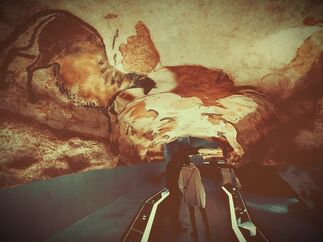
Guests explore one of the Realm's painted caves, circa 1979
The Realm of Man was designed to evoke the primordial state of prehistoric humankind.
Set in a series of mammoth-bone tents, caves, tundras, forests and savannas, it transported guests millions of years into the past, where they relived the evolutionary history of the human species.
History[]
When OmniPark opened in March 1977, this Realm was originally called The Realm of Mind, and was focused on the human brain — specifically, on human consciousness.
Its original attraction was a ride called "The Mystery of Consciousness," which simulated the evolution of human consciousness from a first-person perspective. Narrated by a shamanic woman called the Chemist, this attraction culminated in a colorful simulation of an LSD trip. Documentation of this attraction (and of the Realm as it originally looked) survives only in the form of storyboards and photos published in the 1978 souvenir book "A Journey Through OmniPark."
Facing intense criticism from parents for apparent endorsement of drug use — an accusation bolstered by the fact that members of the hippie community (including Ken Kesey and Timothy Leary [citation needed]) frequently made "pilgrimages" to the park specifically to experience this Realm and its attraction while under the influence of psychedelic drugs — OmniPark demolished the attraction at the end of the tourist season in October 1979.
The entire Realm was closed until May 1981, when its Grand Reopening introduced its new branding as The Realm of Man, featuring "The Story of Man" as its main attraction.
Realm Layout and Design[]
The Realm's entrance took the shape of a giant arch of mammoth tusks. Passing through this entryway, guests emerged into the Great Tent: an enormous vaulted house constructed of bones, pelts and furs. At the center of the tent, a hole let in sunlight. Stone weapons and furs were scattered all around.
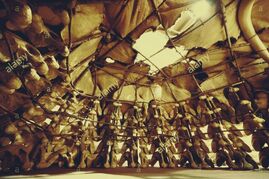
The Great Tent
The Great Tent's west-facing opening led to the Feasting Cave -- one of OmniPark's most unique dining experiences. Under a cave ceiling painted with scenes of the hunt, guests could dine on pit-roasted deer, boar, and other wild-caught meat.
{{The following paragraph contains one or more statements whose factual nature is in dispute. Read more about disputes on the OmniPark Wiki.}}
From 1981 to 1983, park ambassadors clad in furs and animal-bone jewelry would butcher captive gazelles, oryx, deer, rabbits and other animals live in front of guests, using actual flint tools[citation needed]. OmniPark discontinued this practice in response to public outcry over animal cruelty [citation needed].
The Great Tent's east-facing opening led to the Amphitheater -- an open-air performance space where guests could watch a performance that recreated stone-age music.

Heilung - LIFA - Krigsgaldr LIVE
Attraction: The Story of Man[]
This attraction invited guests to travel back to the dawn of human evolution.
As they passed through the queuing area, guests would be treated to murals depicting early hominid habitats such as African savannas and jungles, painted caves, European meadows, pine forests, and the Ice Age tundra. The ride’s boarding area was designed to resemble the painted caves of Lascaux and Chauvet. There, guests boarded four-seater ride vehicles that appeared to be lashed together from mammoth bone and leather.
These vehicles entered a pitch dark room, where animated images of early hominid ancestor species were projected across the domed ceiling and walls. In the opening narration, guests met the Anthropologist (voiced by New York-trained theater actor Roger Forrester, who provided numerous voiceovers throughout OmniPark).
The Anthropologist declared that the only way to understand mankind was to go “back to the very beginning.” Reassuring guests that he had used the Inventor's Time Tunneler technology many times, and had always returned healthy and intact, the Anthropologist opened a spacetime tunnel to “the savanna of Kenya, circa four million years ago.”
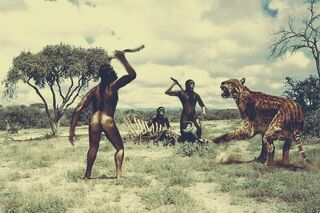
A group of animatronic Australopithecus protect their kill
On this dry grassland, guests saw a troop (or possibly several different troops) of Australopithecus foraging for roots and nuts, fighting off hyenas and big cats, and chasing away a troop of “less evolved” apes by hooting and throwing rocks.
In a nighttime scene, riders saw the troop huddled together against the cold, in a circle they’d cleared within the tall grass. “They are cold,” the Anthropologist explained, “because they know fire only as an enemy — not yet as a friend.” He went on to explain that, because they have not evolved language, “Each of them is alone in his own mind.”
Passing through another dark chamber, riders emerged in “Tanzania’s Olduvai Gorge, two million years later.” There, they witnessed a band of animatronic Homo habilis stalking a herd of zebras, coordinating their attack with a system of chirps and whistles. “By imitating the songs of birds,” the Anthropologist explained, “they have begun to invent something new: language.” (This was one prevailing theory in the late 1970s.)
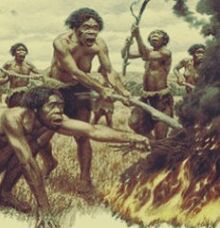
Animatronic Homo habilis and their fire
Riders watched as the Homo habilis cornered and butchered a young zebra - then roasted its flesh over a wildfire burning in the grass. “They have not yet tamed fire,” the Anthropologist explained as guests observed the feast, “but at last, they have befriended it.”
“But something is wrong!” the Anthropologist suddenly exclaimed. “The hunters have become the hunted!” A series of guttural cries alerted the Homo habilis troop to the presence of a pack of carnivorous hominids nearby. The ride vehicles followed the fleeing Homo habilis into a nearby cave, which was pitch dark. The Anthropologist cautioned guests to remain absolutely still and silent, “For we are hunted by Pithecanthropus erectus” [the scientific name for Homo erectus prior to the 1990s].
In one of OmniPark’s most memorable scenes, riders were surprised by puffs of animal-scented air as the troop of “Pithecanthropus erectus” sniffed them in the pitch darkness of the cave. Robotic “hands” emerged from the ride vehicles, giving the sensation that the hunters were pawing and pinching riders’ flesh. At last, a series of high-pitched screams gave evidence that the hunters had killed some of the younger Homo habilis, and were beginning to eat them.
The ride vehicles lurched forward out of the cave, emerging in “Ethiopia’s Great Rift Valley, just over a million years later.” Here, riders got their first view of “anatomically modern Homo sapiens,” who resembled South Africa’s San people. These hunters used spears and bows to take down a wild ox with great expertise - still using similar bird-like calls to coordinate their tactics.
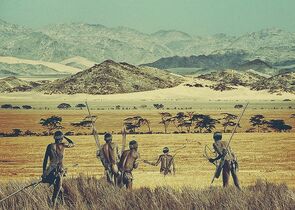
Animatronic Homo sapiens coordinate their hunt
Later, in a rock shelter, riders watched as the animatronic humans used tools to turn the ox’s flesh into leather for clothing, its bones into knives, and its organs into bags and bowstrings. A shaman chanted while the tribe’s women painted scenes of the hunt on the rock shelter’s wall.
The ride vehicles then passed into a chamber where an animated map depicted humankind’s migration across the earth - from eastern Africa across Europe and Asia, throughout the Pacific, and finally into North and South America.
“But we Homo sapiens were not alone in this wide world,” the Anthropologist explained, as the ride vehicles emerged onto an Ice Age tundra, “less than a hundred thousand years ago.” There, a tribe of humans - now clad in sewn clothing of fur and hide - battled a clan of Neanderthals, who fought with stone-tipped spears.
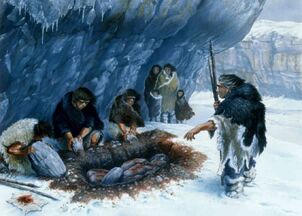
1975 concept art for the Neanderthal funeral scene
The Homo sapiens killed most of the Neanderthals - yet strangely, the riders were taken not to the humans’ victory celebration, but to the Neanderthals’ funeral. Older Neanderthals wept, while younger ones placed garlands of flowers in the graves, and an ancient shaman chanted to a giant cave bear skull.
(In the ride’s original 1981 design, this scene also included a captive human woman being sexually assaulted by two Neanderthals - but this tableau was removed in 1983 following guest complaints [citation needed].)
“Fierce and hardy though they were,” the Anthropologist explained, “the Neanderthals were defeated in the end.” The ride vehicles emerged into a mammoth-bone village, where men and women sewed complex garments, constructed bows and arrows, and carved and painted art - all while speaking to one another in the most complex language yet heard.
The vehicles then entered a vast chamber, filled with animated depictions of all the hominid species encountered throughout the ride. “The story of man is not simply the story of Homo sapiens,” the Anthropologist explained. “It is the story of all of us.”
